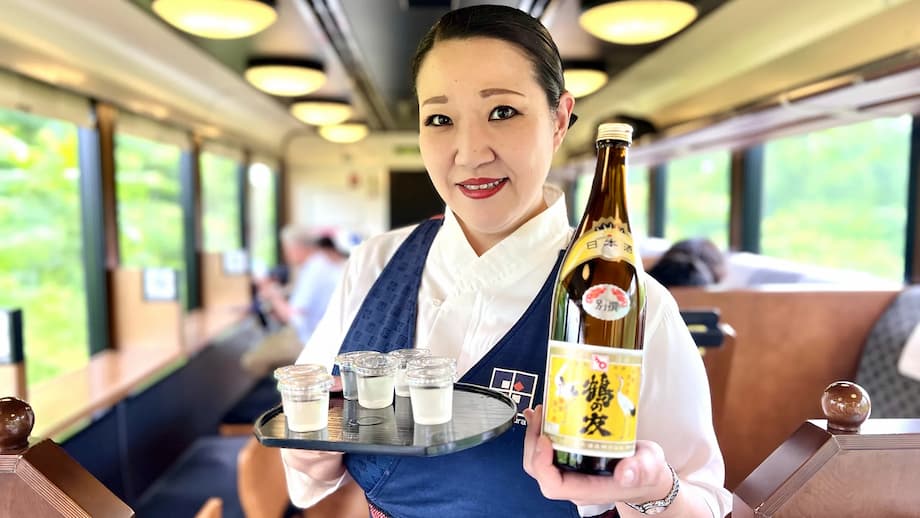Inside Niigata’s moving tasting room
In Niigata, a coastal prefecture that receives deep winter snows and grows much of Japan’s rice, rail travel doubles as a celebration of sake. Visitors can start right at the station by sampling dozens of bottles, then roll through farm fields and coastal cliffs in a glass walled train where staff pour regional brews and musicians play live sets. The experience brings centuries of craft into the present. It is equal parts tasting tour, slow travel, and a window onto a region where water, rice, and winter culture shape what many consider Japan’s cleanest, driest style of sake.
- Inside Niigata’s moving tasting room
- Why Niigata makes great sake
- How the sake train works and what to expect
- Routes, seasons, and how to book
- Station tastings at Ponshukan
- Tradition meets innovation in the snow country
- Brewing with snowmelt, a new generation of makers
- Beyond the train, a sake centered itinerary
- Travel tips and responsible sipping
- What to Know
The journey often begins at Echigo Yuzawa Station, where the Ponshukan tasting corner functions like a sake arcade. Travelers buy a handful of tokens and a small ceramic cup, then work down a wall of dispensers holding more than 100 varieties from across the prefecture. Labels range from crisp, dry junmai to fragrant ginjo styles. A few steps away, shelves are stacked with local rice snacks and onigiri. With taste buds primed, many riders board the Shu*Kura, a special sightseeing service from JR East that turns the idea of a tasting room into a panoramic train carriage. The name fuses shu, a word for sake, and kura, meaning brewery. The asterisk nods to Niigata’s mountains, snow, rivers, and coast, the natural elements that define the drink here.
Why Niigata makes great sake
Niigata’s brewing reputation rests on geology, climate, and farming. Heavy snow blows in from the Sea of Japan, piles up all winter, then trickles down as soft meltwater in spring. This water is famously low in minerals. Brewers say that softness helps yeast work at an even pace, which can produce clean aromas and a dry, light finish. That profile is so linked to place that locals use a phrase, tanrei karakuchi, to describe it. Rice is the other pillar. The prefecture is one of Japan’s largest rice producers and grows sake specific strains such as Gohyakumangoku that polish well and ferment into sharp, restrained flavors. The result is a regional identity built on purity and balance.
From rice to glass
Sake is brewed, not distilled. It starts with milling rice kernels to remove their outer layers. Brewers wash and steam the grains, then dust a portion with koji, a mold that converts starch to sugar. A yeast starter, known as shubo, gets fermentation going. The main mash, called moromi, blends steamed rice, koji rice, water, and yeast in stages over several days. Fermentation can run for weeks at careful temperatures. Finally, the mash is pressed to separate clear sake from rice solids. Choices at every step shape the final taste, from how much the rice is polished to the type of water and yeast, and the length of the ferment. In Niigata, the combination often leads to restrained aromatics and a crisp finish that pairs well with seafood.
The prefecture counts more than 80 breweries, with some estimates near 90. Families have made sake here for centuries. Yoshinagawa, founded in 1548, is one of Japan’s oldest active breweries. Per capita consumption is among the highest in the country, which keeps small producers closely tied to local tastes while still competing on national and international shelves.
How the sake train works and what to expect
JR East’s Koshino Shu*Kura belongs to a class of themed services often called joyful trains, designed for the pleasure of the ride. The retrofitted cars date to the 1970s and feel warm and modern. Car 1 offers spacious seating and large picture windows. Car 2 is the event space with a standing tasting area and a bar. Car 3 has reclining seats and a lounge like zone for socializing. The design encourages people to wander, look out at the scenery, and learn. Staff introduce different breweries during the ride and explain flavors in simple, friendly terms.
Tasting flights feature sake from Niigata makers that change by date and route. One departure might spotlight a crisp daiginjo and a seasonal sparkling sake. Another might focus on a smooth junmai and a limited bottling from a mountain town. Pairings lean local, with snacks and bento assembled from Niigata rice, river fish, mountain vegetables, and coastal specialties. Live music on board ranges from jazz to folk. When the train slows for a scenic stretch, cameras come out and the carriage hums with clinking cups and chatter.
The routes purposely cross the landscapes that make Niigata sake distinctive. Expect inland plains lined with paddies, mountain valleys where snow lingers late into spring, and the Sea of Japan coast where wind hammers the shoreline. Some runs pause at stations with sweeping views. Omigawa Station sits steps from the surf and is a favorite for photos. On afternoon departures, staff often time service so riders can savor a pour while the sun drops behind the water.
Routes, seasons, and how to book
The Shu*Kura name covers three routes that rotate through the year. The core Koshino Shu*Kura runs between Joetsu Myoko and Tokamachi. Yuzawa Shu*Kura links Joetsu Myoko and Echigo Yuzawa, the gateway to the mountains. Ryuto Shu*Kura connects Joetsu Myoko and Niigata City, the coastal capital. Most departures operate on weekends and holidays from spring to late autumn. Winter service is limited in part because the train highlights seasonal scenery and local events.
Reservations are required because capacity is small and tastings are organized. Seats can sell out weeks ahead for peak foliage and holiday dates. Holders of the JR Pass or JR East regional passes can reserve standard seats without an extra fare, then pay on board for drinks and food. Dining packages with set menus and exclusive pours can be booked for Car 1 on specific departures. Travelers who prefer not to drink can choose a nonalcohol plan with local soft drinks and sweets. Check schedules and booking options on the JR East Joyful Trains page and finalize seat reservations at JR ticket counters or via JR East online tools where available.
Station tastings at Ponshukan
Even without stepping on the train, Niigata’s stations serve as tasting rooms. Ponshukan, located inside Echigo Yuzawa, Niigata, and Nagaoka stations, showcases bottles from across the prefecture. The tasting corner works on a coin system. Buy a set of tokens, collect a tiny cup, and choose from a wall of machines. Each dispenser lists the brewery, style, and a short tasting note. It is an easy way to compare a crisp kubota with a fruity kikusui, or to learn how a daiginjo differs from a junmai.
Shops attached to the tasting corners sell sake friendly snacks and crafts from the region. The Echigo Yuzawa branch also hosts a sake themed bath, a playful nod to the area’s hot spring culture. For a quick meal, look for giant onigiri pressed from local koshihikari rice and stuffed with seasonal fillings. The combination of station tasting, regional food counters, and artisan goods makes Ponshukan a destination in its own right.
Tradition meets innovation in the snow country
Brewing in Niigata leans on tradition, yet the region encourages experimentation. Local officials have designated parts of the prefecture as zones for agricultural innovation. Startups are using data tools to match drinkers with bottles, sometimes referred to as sake AI. Others find new uses for byproducts, feeding aquaculture with nutrient rich lees or turning rice waste into biodegradable goods. The goal is to reduce waste, support farmers, and create side businesses that stabilize rural incomes.
Universities and technical schools play a role in this shift. Professors advise small firms and help translate research into commercial practice. In a place that has brewed for hundreds of years, these partnerships keep experienced makers at the center while giving new ideas room to grow. The result is a lively ecosystem where a classic junmai can share space with a limited sparkling expression and where thoughtful packaging and sustainability practices matter as much as flavor.
Brewing with snowmelt, a new generation of makers
On many itineraries, the sake train leads to conversations with producers. In the mountain city of Tokamachi, brewer Tomomi Duquette has drawn attention as a founder who represents a new wave of makers. Her project, Snow Satoyama Sake, emphasizes the qualities that Niigata water brings to fermentation. Snowmelt percolates through granite and sand, arrives in springs with very low mineral content, and gives yeast a calm environment in which to work. That softness translates to a feeling of clarity in the glass.
Visitors who time their trips for winter or early spring can sometimes observe parts of the process. The steps are gentle and repetitive. Rice is washed, soaked, and steamed. Koji rice is prepared in a warm room, then blended with water and yeast in measured stages. Workers stir, test temperature, and taste daily as the mash ferments. Some brewers showcase heirloom techniques or experiment with bubbles and lower alcohol styles made for casual sipping. Tasting side by side with the person who made the bottle draws a straight line from field to fermenter to cup.
Beyond the train, a sake centered itinerary
Niigata City offers brewery tours that layer history onto technique. Imayo Tsukasa, founded in the 1700s, runs short guided visits that end with a tasting flight. The facility is a lesson in how modern quality control sits alongside cedar casks and timber beams. Nearby, markets like Pier Bandai stock fresh seafood and local produce for pairing with your favorite bottle. A short walk links tasting rooms, izakaya that pour regional labels, and shops selling pottery and cups designed for sake.
Those with extra time can add Sado Island, reached by ferry from the mainland. The island’s gold mining history, forested slopes, and rugged coast make a striking backdrop for summer festivals by the famed taiko group Kodo. Trails, beaches, and cultural sites pair well with simple meals of island seafood and Niigata rice. It makes a relaxed follow up to a day of tastings on the mainland.
Travel tips and responsible sipping
Plan dates around the seasons. Cherry blossoms in spring frame the paddies. Summer is green and languid. Autumn brings rice harvests and fiery hillsides. Winter transforms the landscape into a snow scene, and while the train runs less often then, breweries are busy and towns feel cozy. Book seats early, especially for holidays and foliage weekends. Arrive at the station with time to explore Ponshukan before boarding. On the train, pace tastings with water and snacks, and be mindful of your limit. Staff can recommend nonalcohol options. If a pour surprises you, take a photo of the label and ask about buying a small bottle to bring back to your hotel. Many shops can ship within Japan if you do not want to carry glass. The aim is to taste, learn, and enjoy the scenery, all at a comfortable tempo.
What to Know
- JR East’s Koshino Shu*Kura is a sake themed sightseeing train that runs mainly on weekends from spring to late autumn across Niigata Prefecture.
- The three routes are Koshino Shu*Kura between Joetsu Myoko and Tokamachi, Yuzawa Shu*Kura between Joetsu Myoko and Echigo Yuzawa, and Ryuto Shu*Kura between Joetsu Myoko and Niigata City.
- On board, staff pour tasting flights from local breweries, with live music, snacks, and wide window views in three distinct cars.
- Reservations are required, seats are limited, and pass holders can book standard seats with their JR Pass or JR East regional passes.
- Niigata has more than 80 breweries, a rice growing tradition, and soft snowmelt water that shapes its clean, dry sake style.
- Ponshukan tasting corners at Echigo Yuzawa, Niigata, and Nagaoka stations offer coin operated samples from about 100 labels.
- Historic breweries such as Yoshinagawa date to the 1500s, while newer projects and startups explore data tools and sustainable uses for byproducts.
- Side trips include brewery tours in Niigata City and nature and culture on Sado Island, home to the Kodo taiko group’s summer festival.
- Drink responsibly on board, pace tastings with water and food, and consider buying bottles later rather than overindulging on the train.
- Check schedules and booking details on the JR East Joyful Trains page and reserve well ahead for peak travel periods.




